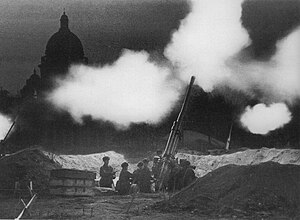
Back Beleg van Leningrad AF حصار لينينغراد Arabic Leninqradın blokadası AZ لنینقرادین بلوکاداسی AZB Ленинград блокадаһы BA Блакада Ленінграда BE Блякада Ленінграда BE-X-OLD Блокада на Ленинград Bulgarian Seziz Leningrad BR Setge de Leningrad Catalan
| Siege of Leningrad | |||||||||
|---|---|---|---|---|---|---|---|---|---|
| Part of the Eastern Front of World War II | |||||||||
 Soviet anti-aircraft battery in Leningrad near Saint Isaac's Cathedral, 1941 | |||||||||
| |||||||||
| Belligerents | |||||||||
|
Naval support: |
| ||||||||
| Commanders and leaders | |||||||||
| Strength | |||||||||
| Initial: 725,000 | Initial: 930,000 | ||||||||
| Casualties and losses | |||||||||
|
|
Glantz estimate:
523,415 KIA and MIA | ||||||||
Soviet civilians: 1,042,000[8]
| |||||||||
The siege of Leningrad was a prolonged military siege undertaken by the Axis powers against the city of Leningrad (present-day Saint Petersburg) on the Eastern Front of World War II. Germany's Army Group North advanced from the south, while the German-allied Finnish army invaded from the north and completed the ring around the city.
The siege began on 8 September 1941, when the Wehrmacht severed the last road to the city. Although Soviet forces managed to open a narrow land corridor to the city on 18 January 1943, the Red Army did not lift the siege until 27 January 1944, 872 days (125 weeks) after it began. The siege became one of the longest and most destructive sieges in history, and it was possibly the costliest siege in history due to the number of casualties which were suffered throughout its duration. An estimated 1.5 million people died as a result of the siege. At the time, it was not classified as a war crime,[12] however, in the 21st century, some historians have classified it as a genocide, due to the intentional destruction of the city and the systematic starvation of its civilian population.[13][14][15][16][17]
- ^ Cite error: The named reference
autogenerated8was invoked but never defined (see the help page). - ^ Cite error: The named reference
autogenerated3was invoked but never defined (see the help page). - ^ Baryshnikov 2003; Juutilainen 2005, p. 670; Ekman, P-O: Tysk-italiensk gästspel på Ladoga 1942, Tidskrift i Sjöväsendet 1973 Jan.–Feb. Archived 4 March 2016 at the Wayback Machine, pp. 5–46.
- ^ "Heeresarzt 10-Day Casualty Reports per Army/Army Group, 1941". Archived from the original on 25 October 2012. Retrieved 28 March 2012.
- ^ "Heeresarzt 10-Day Casualty Reports per Army/Army Group, 1942". Archived from the original on 28 December 2015. Retrieved 24 March 2015.
- ^ "Heeresarzt 10-Day Casualty Reports per Army/Army Group, 1943". Archived from the original on 25 May 2013. Retrieved 25 May 2013.
- ^ "Heeresarzt 10-Day Casualty Reports per Army/Army Group, 1944". Archived from the original on 29 October 2012. Retrieved 3 May 2012.
- ^ a b Glantz 2001, p. 179
- ^ Krivosheev, G. F. (1997). Soviet Casualties and Combat Losses in the Twentieth Century. Greenhill Books. ISBN 978-1853672804. Archived from the original on 18 January 2023. Retrieved 3 October 2020.
- ^ Salisbury 1969, pp. 594
- ^ Glantz 2001, p. 180.
- ^ "Siege Warfare and the Starvation of Civilians as a Weapon of War and War Crime". justsecurity.org. 4 February 2016. Archived from the original on 18 January 2023. Retrieved 3 August 2022.
- ^ Bidlack, Richard; Lomagin, Nikita (2012). The Leningrad Blockade, 1941–1944: A New Documentary History from the Soviet Archives. Translated by Schwartz, Marian. Yale University Press. pp. 1, 36. ISBN 978-0300110296. JSTOR j.ctt5vm646.
Next to the Holocaust, the Leningrad siege was the greatest act of genocide in Europe during the Second World War, because Germany, and to a lesser extent Finland, tried to bombard and starve Leningrad into submission. [...] The number of civilians who died from hunger, cold, and enemy bombardment within the blockaded territory or during and immediately following evacuation from it is reasonably estimated to be around 900,000.
- ^ Ganzenmüller 2005 p. 334
- ^ Hund, Wulf Dietmar; Koller, Christian; Zimmermann, Moshe (2011). Racisms Made in Germany. Münster: LIT Verlag. p. 25. ISBN 978-3-643-90125-5. Archived from the original on 18 January 2023. Retrieved 23 June 2020.
- ^ Vihavainen, Timo; Schrey-Vasara, Gabriele (2011). "Opfer, Täter, Betrachter: Finnland und die Leningrader Blockade". Osteuropa. 61 (8/9): 48–63. JSTOR 44936431.
- ^ Siegl, Elfie (2011). "Die doppelte Tragödie: Anna Reid über die Leningrader Blockade". Osteuropa. 61 (8/9): 358–363. JSTOR 44936455.